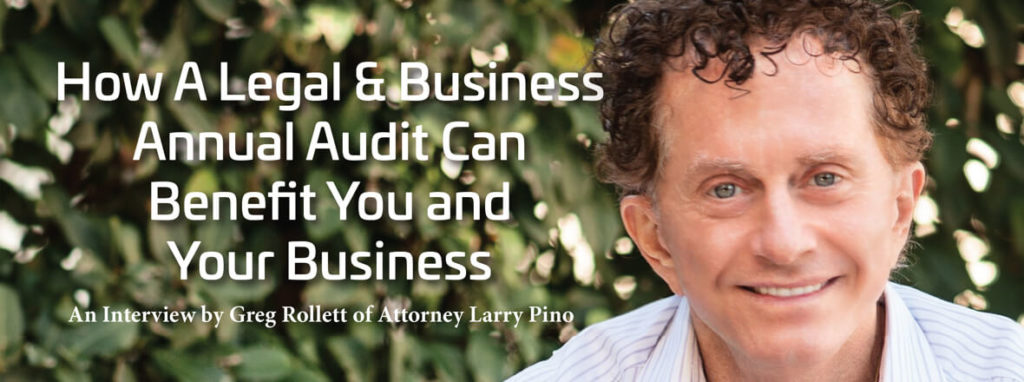An Interview by Greg Rollett of Larry Pino
For this ThoughtLeader® interview, Greg Rollett had a chance to catch up with our friend, Business Lawyer and Entrepreneur, Larry Pino, about the popular program he offers to his clients, called the Legal & Business Annual Audit.
[Greg] So, Larry, how long have you offered this particular program and why do you think it has been so popular?
[LJP] Actually, Greg, for as long as I can remember! And, I have been practicing for over 35 years in this same area of entrepreneur law. I designed the audit as a simple and quick way to work with new clients to get a sense of where they are and where they want to go with their business. I soon found it was also a fast way to get an update on current clients on an annual basis because they were used to the format and reviewing what they had originally said helped them to focus on whether it was still valid or whether they needed to change directions to achieve their current goals. Sometimes, a business hasn’t been set up to excel from the very beginning, and other times, even if it has, the competitive environment is constantly changing, particularly these days. By providing a Legal & Business Audit, and doing it on an annual basis, it allows the business to make sure they are set up to win and then to modify their tactics in a timely fashion as circumstances change.
[Greg] Larry, is there any special thing you are looking for when you conduct one of these audits?
[LJP] Absolutely. What I’m looking for is alignment. In many instances, the business wasn’t properly aligned at the outset. In other instances, it got out of alignment through the passage of time. Think about it this way, if a car is properly aligned, that car is going to go pretty fast and hum along the way. On the other hand, if it is out of alignment, it’s not going to be efficient, will end up burning a lot of gas, and isn’t going to get you where you want to go anywhere near as quickly. It’s all about alignment.
[Greg] I’ve never really heard it explained that way, but it makes sense. So then what does the Audit actually consist of?
[LJP] There are six parts, with each one addressing a particular form of alignment: Strategic Alignment, Structural Alignment, Financial Alignment, Organizational & Operational Alignment, Legal Alignment, and Ownership Alignment.
[Thought Leader] Wow. Now that’s a mouthful!
[LJP] But, you know what, if you’ve been thoughtful about every one of those areas, and you identify how to align them all, you can end up with a well-oiled machine – to extend the metaphor, a very fast sports car. I’ve got to say, understanding how alignment works doesn’t just come from doing these types of audits over the years, it comes from experience in the trenches myself. As you know, while I’m an attorney, I’m also a serial entrepreneur. Companies I’ve incubated ended up on the INC 500 List of Fastest Growing Businesses for a reason – there is profit in alignment and to some degree, just as important, aligning these parts of your business gives you a roadmap to follow.
[Greg] I understand that. Can you describe what is in the Audit itself?
[LJP] Of course. Strategic Alignment tests for the relationship between the products and services the company delivers, the marketing message it communicates, the way the company fulfills that marketing message, and the market it serves. Structural Alignment goes one step further than that and makes sure that the entities of the organization overlap that strategy in a way that serves the company’s objectives and, at the same time, provides for scope and scalability. Financial Alignment addresses the resources of the Company to make sure they are matched up with the opportunities of the company – it solves for capital and growth.
[Greg] Okay, that’s three of them – Strategic, Structural and Financial. Keep going!
[LJP] The next one is Organizational & Operational Alignment. It’s surprising how some companies are internally blind to inefficiency in their organization. Sometimes, it can be as simple as realigning certain human resources from one function to another, supporting a hot new product or emerging segment of the business; other times it consists of trimming in several areas that may be profitable, but are not growing. Along the same lines, organizational inefficiency is usually matched by operational or process inefficiency. By this stage in the Audit you know what levers in your business you need to crank. Organizational & Operational Alignment allows you to crank those levers so you are driving on all cylinders.
[Greg] Okay, Larry, tell us about the Legal Alignment. What is that about?
[LJP] Legal Alignment is directed primarily to transactional documents being used by the business with customers or clients on the one side and vendors on the other. Typically, most businesses I’ve seen for the very first time have documents that achieve less than 50{cd266c1509fca34f59dc93da7daf12a6ee52c6401aabb2126e757d9de7c223fc} of their business objectives and eliminate less than 30{cd266c1509fca34f59dc93da7daf12a6ee52c6401aabb2126e757d9de7c223fc} of their risks. The easiest thing to do – the low-hanging fruit – is to align the transactional documents used by the business with the business itself, which almost inevitably results in transactional documents which are half the size, twice as friendly and actually protect the client better because they are structured to consistently match the owner’s overall personal and business objectives.
[Greg] It’s all making sense, Larry. What about the Ownership Alignment?
[LJP] That’s often the most overlooked. Ownership Alignment involves three things: Asset Protection, Estate Planning and Tax Reduction. A strong alignment around ownership interests in the business, whether it’s a sole proprietorship or a group of owners, allows you the opportunity to align the ownership interests around each individual partner’s estate planning objectives, while simultaneously shielding the owners’ economic interests from any type of external attack, while minimizing taxes in the process. Elegant ownership structures work because they are properly aligned with the rest of the business. Once you understand that you are taking a holistic approach to building a business and protecting the owner’s interest and assets, it all makes operational sense as opposed to the traditional law practice where you only see your lawyer when a problem arises and by then it’s too late to structure what should have been in place for protection from the very beginning.
[Greg] That’s incredible, Larry, but is it going to cost me an arm and a leg to get an Audit from you?
[LJP] Yes, it is incredible; but no, it won’t cost them an arm and a leg. When I’ve been brought in as a consultant, I have charged anywhere from $10,000 to $12,000 to implement a full Audit of the entire organization. But that is not what my objective is here. We have a very unique law firm specializing in what I call entrepreneurship law, which focuses on the needs of entrepreneurs at all stages of their business – from start-up through rapid, triple digit growth. My objective isn’t to make a Legal & Business Audit the end game; the audit allows me the opportunity to understand a client’s business intimately and to be able to then service their every need. That’s why, once I am involved in a professional capacity with my clients, I never lose them. I know their businesses like the back of my hand and I end up in the unique capacity to be able to advise and represent them very personally on anything that has to do with their business or legal needs. So, while it costs me a whole lot more than the $1,295 I charge for onboarding new clients, I write off the balance as nothing other than a business cost I incur in having the opportunity to start helping a new client.
[Greg] $1,295? You can do all of that for just $1,295?
[LJP] No, I can’t. It costs me four times more than that to put together a Legal & Business Audit for a new client. On the other hand, I can tell you that when I’m in the trenches with my client putting together a Legal & Business Audit, you can rest assured my client knows I’m going to be in the trenches with them as they grow their business and as we set things up right to do just that.
[Greg] Okay, Larry, this sounds absolutely unbelievable. How do our readers sign up to hire you as their attorney?
[LJP] Truthfully, not all businesses can benefit from this process. So, rather than exchanges of emails or forms, or anything of that nature, the way I prefer to work is by just simply having an initial phone call. We will be able to tell relatively quickly whether this is the right fit. And, if it is, we can go through exactly what I need in order get to work. My assistant, Cathy Simmons, who has been with me since 1982, can be reached at (407) 206-6516. Call her, schedule a 30-minute initial introductory call, and, by the end of it, both of us will know whether this is the right decision and the right timing for it.
[Greg) Thank you, Larry. This is something I have never heard, the way a law practice can help a client actually save money by setting up systems and organizational models to follow that create a very specific roadmap to reach the client’s overall business objectives.

